2025.07.19
What Is Tairagai? Discovering Japan’s Giant Pen Shell and Its Delicate Flavor
By Chef Yuuki Tanaka, owner of Ise Sueyoshi — Tripadvisor Best of the Best: Japan #1, World #12.(source).

What You’ll Learn in This Article
- What Tairagai (Giant Pen Shell) is and where it comes from
- What part of it is eaten and how it tastes
- Why Japanese chefs treasure this rare shellfish
- Where and when you can try it in Japan
- How Ise Sueyoshi prepares it in kaiseki cuisine
What’s Your Name?
Have You Ever Seen This Shell?
While traveling through Japan, perhaps you stopped by a quiet sushi bar or a refined kaiseki restaurant.
Suddenly, a striking shell appeared before you—broad and elegant, like an open fan.
Did it catch your eye?
This is Tairagai, also known in English as the “Pen Shell.”
True to its name, it resembles the sheath of a calligraphy brush or a traditional folding fan—delicate in shape yet grand in size, sometimes over 20 cm long.
Some of you may have also come across it in Japanese fish markets, its unusual form standing out among other seafood.
In this article, we’ll explore the fascinating world of Tairagai.
Beyond its striking appearance lies a subtle, refined flavor that has long captivated chefs and diners alike in Japanese cuisine.
Let’s take a closer look and uncover what makes this seasonal delicacy so special.
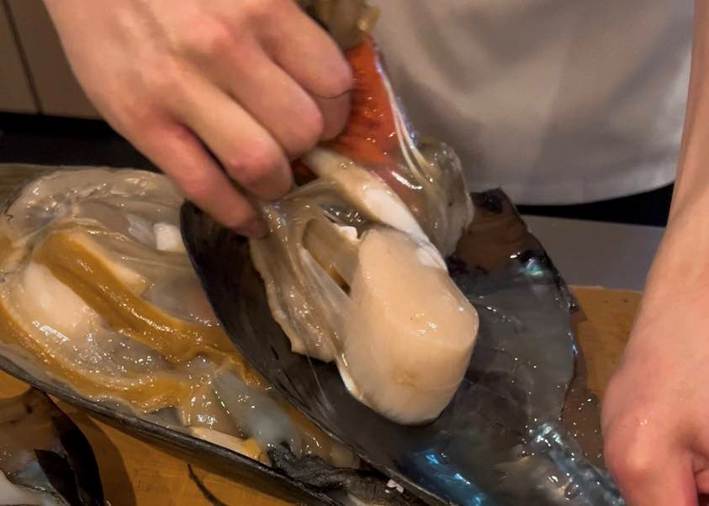
What’s the Taste?
The part of the Tairagai that is typically eaten is the large, white adductor muscle located near the center of the shell.
Plump and thick, it offers a delicate sweetness and a moist, slightly firm texture that fills your mouth with gentle richness.
The outer mantle (called himo in Japanese) can also be eaten if carefully cleaned, but in most cases, only the adductor muscle is served.
The closest flavor comparison is the scallop.
While both have a mild sweetness and natural umami, Tairagai tends to be slightly firmer and meatier. With each bite, the savory richness deepens, offering a pleasant and refined chew.
When cooked, Tairagai reveals yet another layer of character.
A light sear brings out a subtle charred aroma, while steaming gently draws out its elegant umami.
It is one of the rare shellfish that shine both raw and cooked.
Other similar shellfish often mentioned include scallops and mussels.
Scallops tend to be sweeter, softer, and juicier, while mussels—although taxonomically closer—are much smaller and differ greatly in both flavor and use.
Each has its own charm, but Tairagai stands out for its large adductor muscle, fragrant aroma, mild sweetness, and clean, elegant umami—making it particularly well-suited to the subtle flavors of traditional Japanese cuisine.
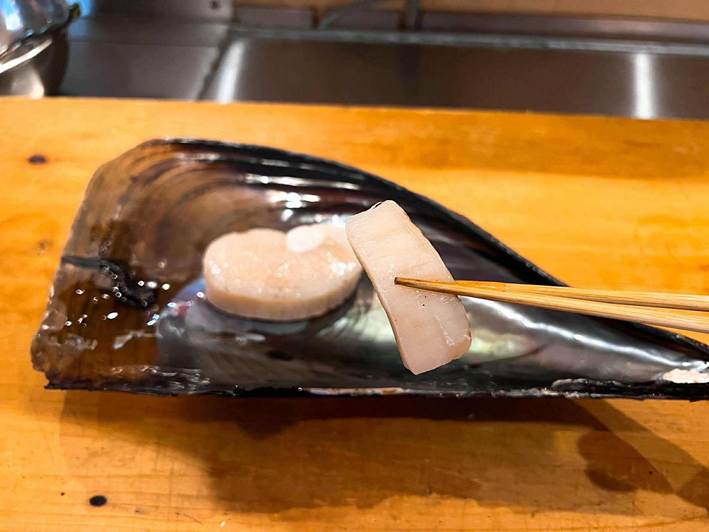
When and Where
Even if you’re intrigued by Tairagai, encountering it on a menu isn’t easy.
That’s because it’s an exceptionally rare and delicate ingredient.
Tairagai is harvested only in limited coastal waters of Japan—primarily in Ariake Bay and the Seto Inland Sea.
Its shell is extremely fragile, making it difficult to handle and nearly impossible to distribute in large quantities.
In recent years, catch volumes have further declined, turning Tairagai into a high-end delicacy found only at select restaurants, even within Japan.
The peak season for Tairagai is from winter to spring, especially April to June, when the meat becomes plump and flavorful.
During this window, top kaiseki and sushi restaurants may feature it as a seasonal highlight.
Although its English name is “Pen Shell,” it is rarely used as an ingredient outside of Japan.
Even though its natural habitat extends across regions, it’s in Japan where the culinary skill and cultural tradition elevate it into a refined dish.
In this sense, Tairagai is truly a flavor you can only discover in Japan.
A fleeting seasonal treasure—one to savor when the opportunity arises.
A Chef’s Favorite Secret
Tairagai is cherished by skilled chefs for its rich umami, delicate aroma, and firm, meaty texture—qualities that allow a single dish to express both technique and seasonality.
Its versatility makes it a favorite in refined Japanese cuisine, where chefs draw out its full potential through various preparations.
Here are four of the most representative ways Tairagai is prepared:
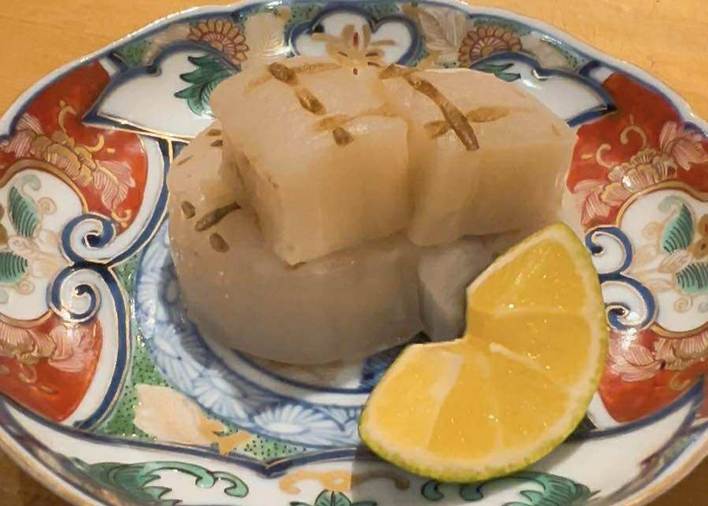
Sashimi
The purest way to experience the essence of Tairagai is through sashimi.
Thinly sliced with care, the adductor muscle has a tender, silky texture that gently melts on the tongue.
As you chew, its subtle sweetness and deep umami unfold slowly.
Served simply with wasabi and soy sauce or a touch of salt, this preparation lets the ingredient shine on its own.
Seared Tairagai (Yaki-shimo Style)
Briefly seared over charcoal or with a torch, this preparation strikes a perfect balance between the delicate texture of raw Tairagai and the rich aroma brought out by flame.
The light charring enhances its natural fragrance and adds a gentle complexity to the texture, offering a deeper experience than sashimi alone.
A squeeze of citrus and a pinch of salt bring out its full flavor—simple, yet unforgettable.
Tempura
Lightly battered and perfectly crisped, Tairagai tempura offers a delightful contrast—crunchy on the outside, tender and plump within.
The heat intensifies the shellfish’s natural umami, while its gentle aroma unfolds with each bite.
A touch of salt highlights its subtle sweetness, while dipping in tempura sauce adds even more depth.
Though fried, this preparation demands refined technique to preserve the shellfish’s elegance.
Teriyaki
Grilled and glazed in a sweet-savory teriyaki sauce, Tairagai takes on a bold and satisfying character.
The caramelized exterior brings out a rich aroma, while the shellfish’s naturally firm texture gives each bite real substance.
Whether served with rice or as a sake pairing, it leaves a lasting impression with its deep umami and hearty presence—showcasing Tairagai at its most robust.
No matter the cooking method, Tairagai challenges chefs to master the art of restraint.
Its appeal lies not in bold flavors, but in the subtle sweetness, gentle aroma, and lingering umami it offers.
It’s this quiet elegance that makes Tairagai a favorite among culinary professionals.

Cooking Tips
Tairagai may seem intimidating to handle due to its large size and unique shape,
but with a few key techniques, it can be prepared both beautifully and safely.
How to Open Tairagai: The Basics
Start by opening the shell. Like scallops, Tairagai has an adductor muscle attached to one side of the shell.
Use a shell knife or spatula to gently insert into the gap between the shells and carefully pry it open.
Be mindful not to damage the adductor muscle, and aim to detach the two muscles—one on each end of the shell.
Removing and Cleaning the Adductor Muscle
Once opened, the large white adductor muscle at the center is typically the only part used.
Carefully remove the surrounding mantle (himo) and internal organs, then rinse off any sand or residue as needed.
The mantle can also be eaten if properly cleaned to remove any sliminess or debris.
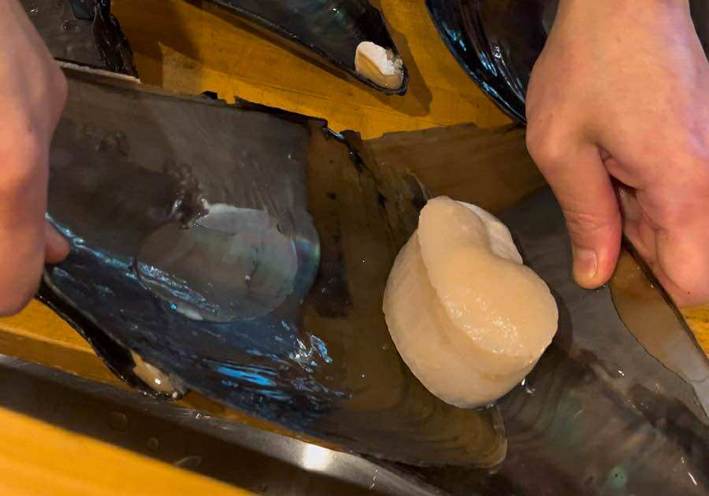
Tips for Cooking Tairagai
The key to cooking Tairagai is simple: don’t overdo it.
Because of its delicate texture, proper heat control is essential to preserve its tenderness and flavor.
- Grilling (Aburi): Lightly sear the surface to bring out a fragrant aroma while keeping the inside moist and tender.
- Steaming: Gently cooks the flesh, locking in the shellfish’s subtle umami and aroma.
- Teriyaki: Adds depth and savoriness with a sweet-savory glaze. Be careful not to overcook—the texture can quickly become tough.
As it tightens slightly with heat, the ideal finish is medium rare—just enough to enhance its natural richness without drying it out.
In Japanese cuisine, Tairagai challenges the chef to balance restraint and enhancement.
A single thoughtful touch can bring out its full potential.
This is a shellfish best appreciated in the hands of skilled professionals who can elevate its quiet elegance.
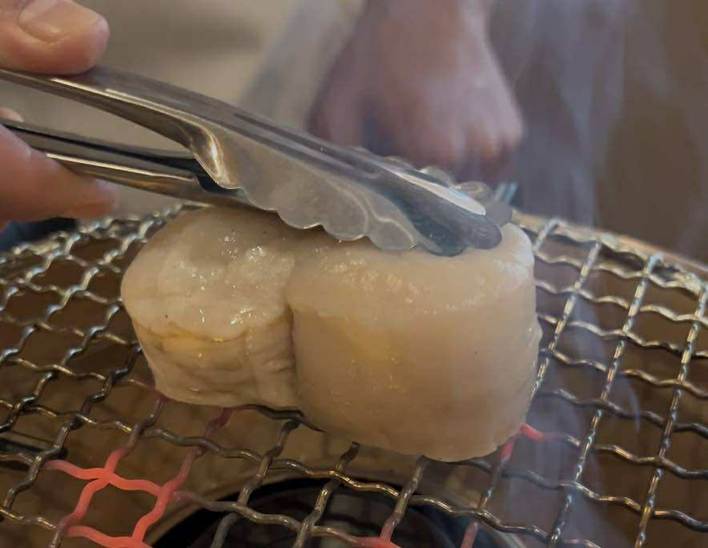
Ise Sueyoshi’s Recipes
At Ise Sueyoshi, we serve Tairagai in a variety of ways, thoughtfully tailored to the season, the composition of each guest party, and the overall balance of the course menu.
Because this ingredient possesses both gentle sweetness and deep umami—without any overpowering traits—we focus on subtle techniques that bring out its natural character without unnecessary embellishment.
Sashimi
The purest way to highlight the beauty of Tairagai is through simple sashimi.
We carefully adjust the thickness and cut based on the condition of the shellfish that day, then lightly sear the surface to create a yaki-shimo (grilled edge) finish.
Guests are invited to squeeze fresh sudachi (a Japanese citrus) over a small mound of salt, creating a delicate dipping sauce that enhances the flavor without overpowering it.
The presentation features Tairagai’s own black shell as a natural plate.
Its dark, elegant color makes a perfect canvas for vibrant seasonal vegetables and garnishes, turning each dish into a visual celebration of the season.

Teriyaki-Style Tairagai
The whole adductor muscle of the cleaned Tairagai is grilled without slicing.
We quickly sear it with a house-made sweet and savory teriyaki glaze, allowing the heat to bring out its rich aroma and enhance the firm, satisfying texture of the shellfish.
To finish, we slightly caramelize the surface of the sauce, adding a delicious layer of charred soy-based fragrance that deepens the overall flavor.
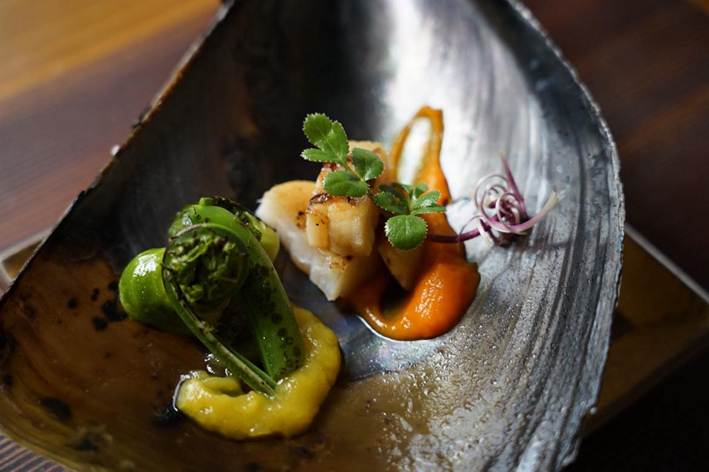
Tairagai with Herb-Infused Dashi Jelly
The Tairagai adductor muscle is lightly blanched and sliced to catch the jelly well.
It’s then delicately mixed with a refreshing dashi-based jelly and finely chopped aromatics like myoga (Japanese ginger), kinome (Japanese pepper leaf), and sudachi citrus.
This dish offers a cool, clean flavor that refreshes the palate—perfect for the middle of a kaiseki course.
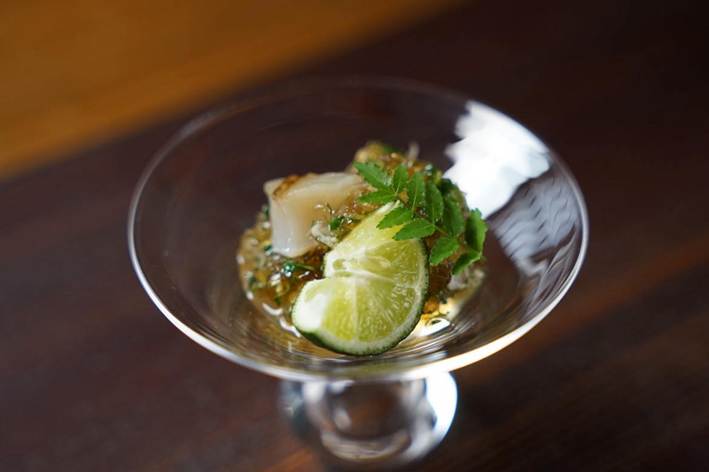
Kaiseki and the Best Season
A Taste of Japanese Spring, Best Savored in Kaiseki Cuisine
Tairagai is at its best in spring—especially from April to June—when the shellfish plumps up and its flavor deepens.
This season in Japan is a paradise for shellfish lovers: clams, turban shells, and cockles also reach their peak, nourished by the rhythm of the tides.
Among them, Tairagai stands out as a must-try delicacy, particularly when enjoyed through the lens of kaiseki, Japan’s refined multi-course cuisine.
Kaiseki is more than just a meal—it’s a cultural expression of the seasons, where each dish highlights the natural essence of the ingredients.
Delicate shellfish like Tairagai shine most beautifully in this context, where subtlety and precision bring out their true character.
Sometimes, a single dish from your journey lingers in your memory—its taste, its aroma, the quiet impression it left behind.
That fleeting moment becomes tied to the place, and the desire to return is born.
We hope that this small seasonal treasure, found in the heart of Japanese spring, becomes part of your unforgettable experience.
May your journey through Japan be rich, delicious, and deeply rewarding.
Read more: What is Kaiseki cuisine?
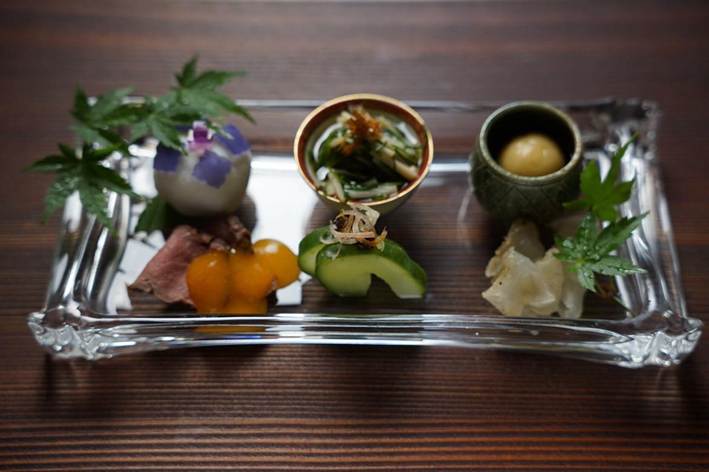
About Ise Sueyoshi
Ise Sueyoshi is a small and discreet Japanese restaurant nestled in the heart of Roppongi, Tokyo.
Centering around kaiseki cuisine that reflects the landscapes and seasons of Japan, we bring the finest seasonal ingredients from carefully selected producers—showcasing each ingredient at the very peak of its brilliance.
Among them, Tairagai (pen shell), which arrives with the coming of spring, is one of the finest examples of a “seasonal mirror”—a delicacy that can only be enjoyed during a limited window each year.
At Ise Sueyoshi, we offer only omakase-style kaiseki courses, designed with care and attentiveness.
We respectfully accommodate requests for vegetarian, vegan, or gluten-free options—ensuring that every guest leaves satisfied.
For more about our vegan or vegetarian philosophy please visit this page.
For more about our gluten-free please visit this page.
Each dish is carefully constructed based on the ingredients that arrive that day, with fine adjustments made for each individual guest. This devotion to detail is at the core of what we do.
We welcome many guests from around the world and are always committed to explaining the stories and cultural context behind our ingredients with heartfelt hospitality.
All ingredients and sake are carefully sourced from the chef’s home region of Mie Prefecture.
At Ise Sueyoshi, we offer kaiseki cuisine that fully embraces Japan’s most celebrated ingredients.
For example, the spiny lobster from Mie’s coastal waters offers a springy texture and elegant sweetness.
Tenderly cooked abalone reveals a deep, fragrant aroma and soft texture, while wagyu beef from Iga in Mie literally melts in the mouth with rich, savory flavor.
We also serve rare ingredients such as wild-caught fugu (pufferfish)—a true rarity in Tokyo—and a seasonal tuna course using the highest quality cuts from Minami-Ise.
And just like with tairagai, each seasonal ingredient is prepared using techniques that best showcase its character in that very moment.
Read More about fugu (pufferfish)
Read More about Ise Ebi Lobster
To share the stories behind these exceptional ingredients, Ise Sueyoshi has created a special booklet called the “Producers’ Almanac”—of which only three copies exist in the world.
Each course is introduced alongside the people and places behind it, including a dedicated section on dashi, featuring the origins, production methods, and flavor profiles of both kombu and katsuobushi.
“Circulation of the Heart”—this is our philosophy: to treat every ingredient with respect, to convey the passion of its producers through our cuisine, and to return our guests’ sense of wonder back to those who cultivated it.
If your journey to Japan coincides with the season of tairagai,
we warmly invite you to visit Ise Sueyoshi and experience its delicate flavor and the stories behind every dish.
Read More about Chef Yuuki
The Story of Tokyo’s Best Chef, Yuuki Tanaka: Bringing the Blessings of His Hometown to the World
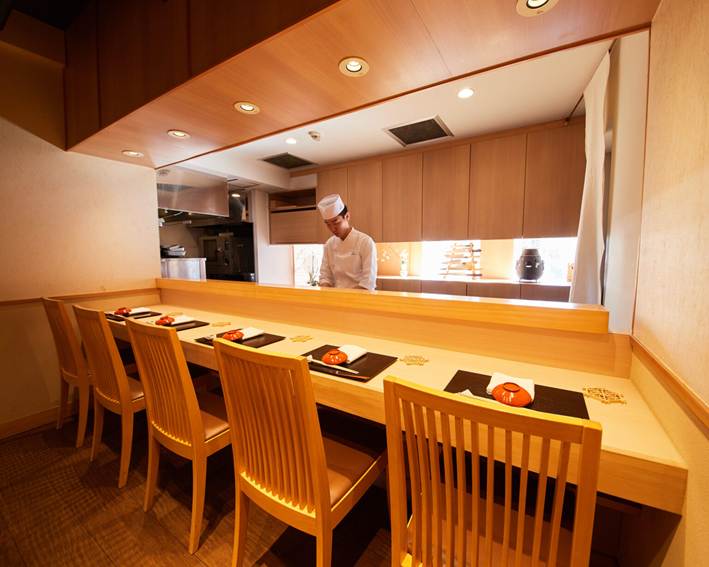
We are proud to continue delivering an exceptional dining experience that earned us the Tripadvisor Travelers’ Choice Best of the Best 2024 award, ranking among the Best Restaurants in Tokyo. Our commitment to excellence in service and our dedication to offering the finest kaiseki dining experience in Tokyo remain unwavering. Discover more about our journey to becoming one of the best restaurants in the city[here].

Visit Ise Sueyoshi
Location: Conveniently located 12 minutes from Roppongi Station and 8 minutes from Hiroo Station.
Hours: Open 5:00 PM – 10:00 PM, reservations only. Closed on Sundays and Mondays.
Book Your Experience ☟
Reservation Information
In response to many requests from our guests, Ise Sueyoshi now accepts reservations up to 180 days in advance of your preferred dining date.
With only 10 seats available, we are committed to providing a smooth and personalized reservation experience.
To ensure you don’t miss the opportunity to celebrate your important anniversaries or special occasions with us, we highly recommend making your reservation as soon as your plans are set.
If you are planning a trip to Japan, we warmly invite you to include a special moment at Ise Sueyoshi in your itinerary.
Many of our guests also choose us for their final evening in Japan, as a beautiful and memorable way to conclude their journey.
Please note that our reservation policies may change without prior notice. For the latest updates, please refer to our reservation page.
Conclusion
At Ise Sueyoshi, we humbly invite you to experience a dining journey that caters to all dietary needs. Whether you’re vegan, halal, or have specific preferences, we are here to create a memorable and inclusive dining experience for you, especially for special occasions like a honeymoon.
Recommended Blog Posts
On our blog, we offer further insights into Tokyo’s rich food culture and the unique culinary experiences we provide at Ise Sueyoshi. Be sure to check out these recommended posts:
Where Fireworks Meet Tokyo Kaiseki: A Summer Night of Elegance |
Why You Must Try Kaiseki Cuisine in Tokyo: A Unique Experience of Culinary Art and Intellectual Delight |
@isesueyoshi
o 🏆 Awarded the prestigious Best Luxury Restaurant by TripAdvisor
o 🌍 Ranked 2nd worldwide, 1st in Japan, and 1st in Asia
o ⭐ Google rating of 4.9 (as of 2024)
o ✅ Vegan-friendly
o ✅ Halal selections
o ✅ Gluten-free options
o ✅ Vegetarian delights
o ✅ Pork-free choices
o ✅ Perfect for pescatarians
o 🌈 Welcoming and inclusive environment for LGBTQ guests
o 🚃 Just a 12-minute walk from Roppongi Station or 8-minutes from Hiroo Station
o ⏰ 5:00 PM – 10:00 PM (reservations-only)
o 📅 Closed on Sun and Mon
